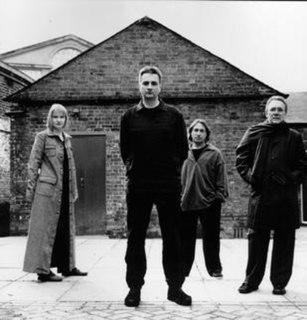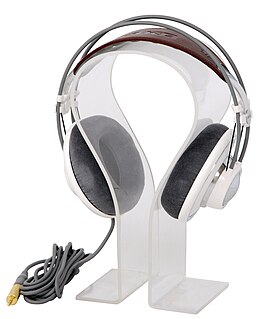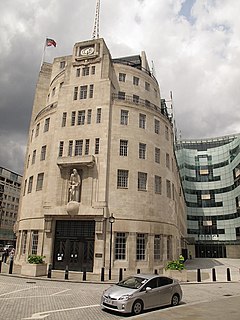
Radar is a detection system that uses radio waves to determine the range, angle, or velocity of objects. It can be used to detect aircraft, ships, spacecraft, guided missiles, motor vehicles, weather formations, and terrain. A radar system consists of a transmitter producing electromagnetic waves in the radio or microwaves domain, a transmitting antenna, a receiving antenna and a receiver and processor to determine properties of the object(s). Radio waves from the transmitter reflect off the object and return to the receiver, giving information about the object's location and speed.
Noise music is a category of music that is characterised by the expressive use of noise within a musical context. This type of music tends to challenge the distinction that is made in conventional musical practices between musical and non-musical sound. Noise music includes a wide range of musical styles and sound-based creative practices that feature noise as a primary aspect.

Very low frequency or VLF is the ITU designation for radio frequencies (RF) in the range of 3 to 30 kilohertz (kHz), corresponding to wavelengths from 100 to 10 kilometers, respectively. The band is also known as the myriameter band or myriameter wave as the wavelengths range from one to ten myriameters. Due to its limited bandwidth, audio (voice) transmission is highly impractical in this band, and therefore only low data rate coded signals are used. The VLF band is used for a few radio navigation services, government time radio stations and for secure military communication. Since VLF waves can penetrate at least 40 meters (120 ft) into saltwater, they are used for military communication with submarines.

Art of Noise were an English avant-garde synth-pop group formed in early 1983 by engineer/producer Gary Langan and programmer J. J. Jeczalik, along with arranger Anne Dudley, producer Trevor Horn and music journalist Paul Morley. The group had international Top 20 hits with "Kiss" and the instrumental "Peter Gunn", which won a 1986 Grammy Award.

Headphones are a pair of small loudspeaker drivers worn on or around the head over a user's ears. They are electroacoustic transducers, which convert an electrical signal to a corresponding sound. Headphones let a single user listen to an audio source privately, in contrast to a loudspeaker, which emits sound into the open air for anyone nearby to hear. Headphones are also known as earspeakers, earphones or, colloquially, cans. Circumaural and supra-aural headphones use a band over the top of the head to hold the speakers in place. The other type, known as earbuds or earpieces consist of individual units that plug into the user's ear canal. In the context of telecommunication, a headset is a combination of headphone and microphone. Headphones connect to a signal source such as an audio amplifier, radio, CD player, portable media player, mobile phone, video game console, or electronic musical instrument, either directly using a cord, or using wireless technology such as Bluetooth, DECT or FM radio. The first headphones were developed in the late 19th century for use by telephone operators, to keep their hands free. Initially the audio quality was mediocre and a step forward was the invention of high fidelity headphones.
A transducer is a device that converts energy from one form to another. Usually a transducer converts a signal in one form of energy to a signal in another.

Active noise control (ANC), also known as noise cancellation, or active noise reduction (ANR), is a method for reducing unwanted sound by the addition of a second sound specifically designed to cancel the first.

Broadcasting House is the headquarters of the BBC, in Portland Place and Langham Place, London. The first radio broadcast from the building was made on 15 March 1932, and the building was officially opened two months later, on 15 May. The main building is in Art Deco style, with a facing of Portland stone over a steel frame. It is a Grade II* listed building and includes the BBC Radio Theatre, where music and speech programmes are recorded in front of a studio audience, and the lobby that was used as a location for filming the 1998 BBC television series In the Red.
Power noise is a form of industrial music and a fusion of noise music and various styles of electronic dance music. It should not be confused with "power electronics", which is not influenced by electronic dance music and is closer to harsh noise. Its origins are predominantly European.

"Dragnet" is an instrumental theme from the radio and television show of the same name. It was composed by Walter Schumann for the radio show, and was also used on the subsequent television series and later syndication of the TV series under the name "Badge 714". The theme is in two parts: an opening signature "Main Title" and the "Dragnet March" used over the end credits.

A radio producer oversees the making of a radio show. The job title covers several different job descriptions:

In radio reception, noise is unwanted random electrical signals always present in a radio receiver in addition to the desired radio signal. Radio noise is a combination of natural electromagnetic atmospheric noise created by electrical processes in the atmosphere like lightning, manmade radio frequency interference (RFI) from other electrical devices picked up by the receiver's antenna, and thermal noise present in the receiver input circuits. The level of noise determines the maximum sensitivity and reception range of a radio receiver; if no noise were picked up with radio signals, even weak transmissions could be received at virtually any distance by making a radio receiver that was sensitive enough. With noise present, if a radio source is so weak and far away that the radio signal in the receiver has a lower amplitude than the average noise, the noise will drown out the signal.

Japanoise, a portmanteau of "Japanese" and "noise", is the noise music scene of Japan.
Rock Me Baby is an American sitcom that aired on UPN from September 15, 2003 until May 25, 2004. Set in Denver, Colorado, Rock Me Baby stars actor and comedian Dan Cortese as Jimmy Cox, co-host of a popular Denver radio show with his best friend, Carl, played by Carl Anthony Payne II. Bianca Kajlich plays Beth Cox, Jimmy's wife, and the two have a baby named Otis. Tammy Townsend plays Beth's best friend, Pamela, who is obsessed with the glamorous life.
WMGS is a commercial FM radio station licensed to serve Wilkes-Barre, Pennsylvania. The station is owned by Cumulus Media, through licensee Radio License Holding CBC, LLC, and broadcasts an adult contemporary format. Its broadcast tower is located on Penobscot Knob near Mountain Top at.

Foley is the reproduction of everyday sound effects that are added to film, video, and other media in post-production to enhance audio quality. These reproduced sounds can be anything from the swishing of clothing and footsteps to squeaky doors and breaking glass. The best Foley art is so well integrated into a film that it goes unnoticed by the audience. It helps to create a sense of reality within a scene. Without these crucial background noises, movies feel unnaturally quiet and uncomfortable.
Mort Aux Vaches: Locomotive Breath is a live album by the Japanese noise musician Merzbow, recorded for VPRO radio in Amsterdam. The same European tour also produced the live album Noizhead.

Chance Dylan Waters, is an independent Australian hip hop artist and record producer. As Phatchance, Waters was a founder of the group, Natural Causes, in 2003 which issued an album, The Incidental Noise Demo, and toured nationally. The group disbanded later that year.

Pornoise/1 kg is a box set album by the Japanese noise musician Merzbow. Additional material from the sessions was released as Pornoise/Extra.














